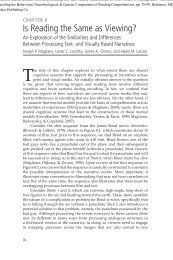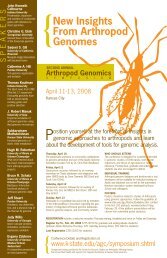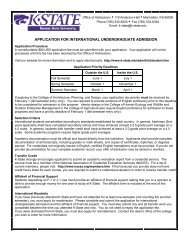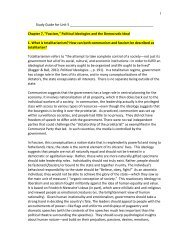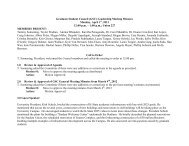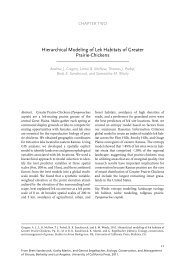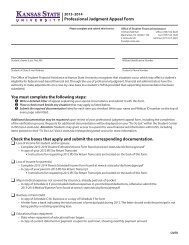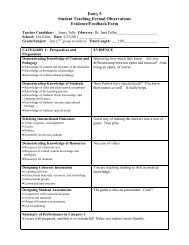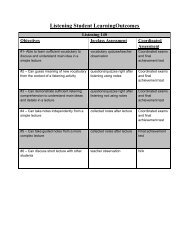Estimation of Demographic Parameters from Live ... - BioOne
Estimation of Demographic Parameters from Live ... - BioOne
Estimation of Demographic Parameters from Live ... - BioOne
You also want an ePaper? Increase the reach of your titles
YUMPU automatically turns print PDFs into web optimized ePapers that Google loves.
should increase at the same rate, and estimates <strong>of</strong> ^k r for adults<br />
may be extrapolated to the entire population. Investigators<br />
should apply temporal symmetry models with caution if agespecific<br />
variation in fecundity and survival is likely to be<br />
complex, or if deviations <strong>from</strong> stable age distributions are<br />
expected. Direct comparisons <strong>of</strong> ^k p and ^k r are somewhat<br />
inappropriate, but Sandercock and Beissinger (2002) found<br />
that field estimates <strong>of</strong> ^k <strong>from</strong> the 2 types <strong>of</strong> models were<br />
comparable for at least one bird population.<br />
Temporal symmetry models <strong>of</strong>fer at least 3 advantages.<br />
First, temporal symmetry models permit direct estimation <strong>of</strong><br />
k without requiring a complete census <strong>of</strong> the population or<br />
estimation <strong>of</strong> all the demographic rates needed to parameterize<br />
a matrix model. Thus, investigators can use estimates<br />
<strong>of</strong> ^k r to assess population trajectory even if abundance is<br />
unknown. These features are particularly helpful when<br />
working with species <strong>of</strong> conservation concern where<br />
demographic data may be limited. Second, ^kr explicitly<br />
includes gains <strong>from</strong> immigration, which have been included<br />
in only a few matrix models for wildlife populations (Cooch<br />
et al. 2001, Sandercock and Beissinger 2002, Webb et al.<br />
2002). Without inclusion <strong>of</strong> immigrants, ^kp may underestimate<br />
the expected rate <strong>of</strong> population change (Franklin et<br />
al. 2004). Last, seniority parameters are analogous to<br />
elasticity values <strong>from</strong> matrix models because investigators<br />
can use f to identify important components <strong>of</strong> ^k (Nichols et<br />
al. 2000). Survival has a greater effect on ^k r if f . 0.5,<br />
recruitment has a greater effect on ^k r if f , 0.5, and the 2<br />
demographic processes have equal influence if f ¼ 0.5.<br />
Empirical applications <strong>of</strong> temporal symmetry models are<br />
few. A few studies have used reverse-time modeling alone to<br />
investigate factors affecting recruitment in populations <strong>of</strong><br />
birds (Pradel et al. 1997b, Cooch et al. 1999, Oro and Pradel<br />
2000, Cam et al. 2005). Investigators have used the f-<br />
parameterization <strong>of</strong> the temporal symmetry models to<br />
explore factors affecting recruitment in freshwater mussels<br />
(3 spp.; Villella et al. 2004), snakes (2 spp.; Webb et al.<br />
2002), and small mammals (2 spp.; Lima et al. 2003). Other<br />
studies have used the k-parameterization to obtain direct<br />
estimates <strong>of</strong> ^k for diamondback terrapins (Malaclemys<br />
terrapin; Mitro 2003), white-winged scoters (Melanitta<br />
fusca; Alisauskas et al. 2004), marbled murrelets (Brachyramphus<br />
marmoratus; Cam et al. 2003), raptorial birds<br />
([Rostrhamus sociabilis] Dreitz et al. 2002; [Strix occidentalis<br />
occidentalis] Franklin et al. 2004), green-rumped parrotlets<br />
(Forpus passerinus; Sandercock and Beissinger 2002), rubythroated<br />
hummingbirds (Hilton and Miller 2003), songbirds<br />
(4 spp.; Julliard 2004), and yellow-bellied marmots<br />
(Marmota flaviventris; Ozgul et al. 2006). At least 4 <strong>of</strong> the<br />
above studies have reported both / and f: hummingbirds<br />
had low apparent survival and seniority values (^/ , 0.43 and<br />
^f ¼ 0.36), scoters had intermediate values (^/ ¼ 0.81 and ^f ¼<br />
0.83), and terrapins and murrelets had high values (^/ . 0.92<br />
and ^f . 0.84). In the latter 2 species, high seniority values<br />
indicate that survival had .5 times <strong>of</strong> an effect on ^k than<br />
recruitment. This sample <strong>of</strong> studies is limited, but the<br />
variation in seniority values is consistent with interspecific<br />
comparisons <strong>of</strong> matrix models where elasticity <strong>of</strong> adult<br />
survival tends to be high in long-lived species (Heppell<br />
1998, Heppell et al. 2000, Sæther and Bakke 2000).<br />
Temporal symmetry models have 4 potential drawbacks<br />
(Franklin 2001, Hines and Nichols 2002, Nichols and Hines<br />
2002). First, they usually require long time series <strong>of</strong> data.<br />
Time-dependence in both / and p leads to inestimable<br />
terms in both the first and last intervals <strong>of</strong> the study period<br />
(b ¼ /p), and n occasions would yield n 3 estimates <strong>of</strong> ^k.<br />
For example, a 4-year study <strong>of</strong> snail kites yielded a single<br />
estimate <strong>of</strong> ^k (Dreitz et al. 2002). Second, temporal<br />
symmetry models are sensitive to changes in sampling area.<br />
Contraction and expansion <strong>of</strong> the boundaries <strong>of</strong> a study site<br />
lead to losses and gains <strong>of</strong> marked individuals that temporal<br />
symmetry models treat as changes in population size. Third,<br />
behavioral responses to trapping, heterogeneity <strong>of</strong> capture,<br />
and failure to account for losses at capture are likely to bias ^k<br />
(Hines and Nichols 2002). Last, temporal symmetry models<br />
work well for a population without age-structure, but<br />
reverse-time modeling becomes more complex if a sample<br />
includes individuals marked as young and as adults. At<br />
present, there is no straightforward approach for handling<br />
age-structure in temporal symmetry models, although a<br />
combined reverse-time and robust design model (Ramsey<br />
2005) or a combined robust design and multi-strata model<br />
(Nichols et al. 2000) may be viable options.<br />
Robust Design Models<br />
Robust design models are similar to CJS models in that the<br />
encounter histories are coded with 1 ¼ detected and 0 ¼ not<br />
encountered. Robust design models differ <strong>from</strong> CJS models<br />
in that investigators must subdivide primary sampling<br />
periods into shorter secondary sampling periods (Fig. 1).<br />
Robust design models assume that populations are open<br />
between primary sampling periods but closed within<br />
secondary sampling periods (Kendall and Nichols 1995,<br />
Kendall et al. 1997), which permits estimation <strong>of</strong> temporary<br />
emigration <strong>from</strong> a sampling area (Schaub et al. 2004). A key<br />
assumption <strong>of</strong> this model is that the survival rates are the<br />
same for individuals inside and outside <strong>of</strong> the sampling area.<br />
Robust design models perform well under some violations <strong>of</strong><br />
the closure assumption (Kendall 1999), and recent formulations<br />
relax the assumption <strong>of</strong> closure to allow staggered<br />
entry and exit <strong>of</strong> individuals <strong>from</strong> the sampling area within<br />
primary periods (Schwarz and Stobo 1997, Kendall and<br />
Bjorkland 2001, Bailey et al. 2004a, Kendall 2004).<br />
In the CJS model, the probability <strong>of</strong> encounter (p) is the<br />
product <strong>of</strong> site propensity (d) and the true probability <strong>of</strong><br />
detection (p*). In the robust design model, p* is estimated<br />
<strong>from</strong> the closed population data in the secondary samples,<br />
along with the probability <strong>of</strong> recapture (c) and population<br />
size (N). If the closed portion <strong>of</strong> the model reveals that pˆ* ¼<br />
1, then encounter rates are effectively an estimate <strong>of</strong> site<br />
propensity (pˆ ¼ ^d; Anderson et al. 2001). In the case <strong>of</strong><br />
random temporary emigration, investigators use closed<br />
population statistics to estimate pˆ<br />
t and open population<br />
statistics to estimate pˆt and calculate the probability <strong>of</strong><br />
Sandercock Mark–Recapture Analyses <strong>of</strong> <strong>Live</strong>-Encounter Data 1509



